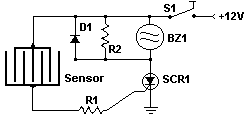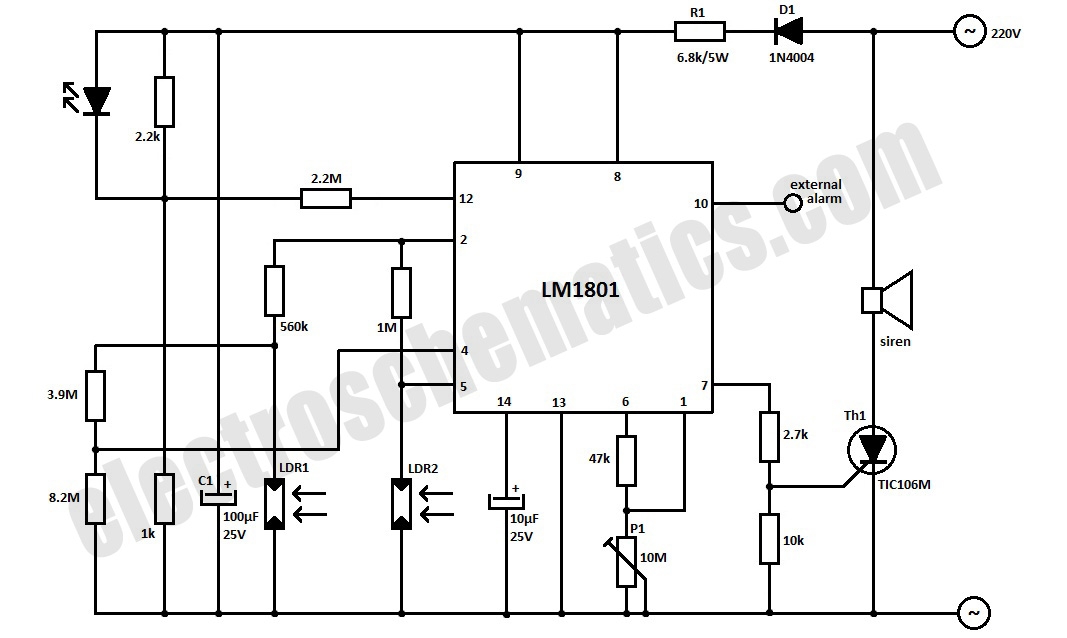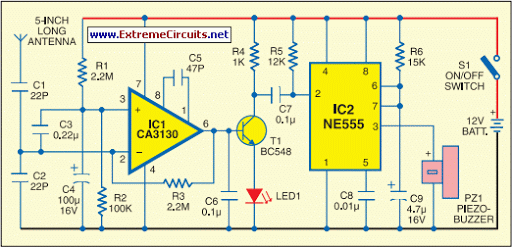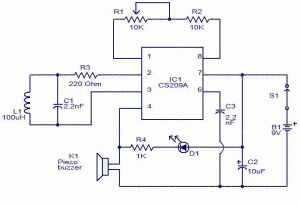
Rain Detector

This circuit uses a sensor made of a small piece of etched PC board and a simple SCR circuit to detect rain and sound a buzzer. The SCR could also be used to activate a relay, turn on a lamp, or send a signal to a security system. More: The sensor is a small piece of PC board etched to the pattern shown in the schematic. The traces should be very close to each other, but never touching. A large spiral pattern would also work. Make sure to use a loud buzzer.
The described circuit is a rain detection system that utilizes a sensor constructed from a small piece of printed circuit (PC) board. The sensor is designed with etched traces that are closely spaced without touching, allowing it to detect moisture effectively. This arrangement can be optimized in various patterns, including a large spiral, to enhance sensitivity to rain.
When rainwater bridges the gap between the traces on the sensor, it completes an electrical circuit, triggering the silicon-controlled rectifier (SCR). The SCR serves as a switch that can be activated by the low current generated by the sensor when rain is detected. Once the SCR is triggered, it can perform multiple functions depending on the circuit design. For instance, it can energize a loud buzzer to provide an audible alert, activate a relay to control higher power devices such as lamps, or send a signal to a security system to indicate the presence of rain.
The choice of buzzer is critical; it must be loud enough to be heard under various environmental conditions. The circuit may also include additional components such as resistors and capacitors to stabilize the SCR operation and filter out noise, ensuring reliable performance. Proper attention should be given to the power supply requirements of the SCR and the buzzer to prevent damage and ensure longevity of the components used in the circuit.
This rain detection system can be utilized in various applications, including automated irrigation systems, home security setups, and weather monitoring stations, making it a versatile addition to electronic projects.This circuit uses a sensor made of a small piece of etched PC board and a simple SCR circuit to detect rain and sound a buzzer. The SCR could also be used to activate a relay, turn on a lamp, or send a signal to a security system.
# The sensor is a small piece of PC board etched to the pattern showen in the schematic. The traces should be very close to each other, but never touching. A large spiral pattern would also work. # Make sure to use a loud buzzer. 🔗 External reference
The described circuit is a rain detection system that utilizes a sensor constructed from a small piece of printed circuit (PC) board. The sensor is designed with etched traces that are closely spaced without touching, allowing it to detect moisture effectively. This arrangement can be optimized in various patterns, including a large spiral, to enhance sensitivity to rain.
When rainwater bridges the gap between the traces on the sensor, it completes an electrical circuit, triggering the silicon-controlled rectifier (SCR). The SCR serves as a switch that can be activated by the low current generated by the sensor when rain is detected. Once the SCR is triggered, it can perform multiple functions depending on the circuit design. For instance, it can energize a loud buzzer to provide an audible alert, activate a relay to control higher power devices such as lamps, or send a signal to a security system to indicate the presence of rain.
The choice of buzzer is critical; it must be loud enough to be heard under various environmental conditions. The circuit may also include additional components such as resistors and capacitors to stabilize the SCR operation and filter out noise, ensuring reliable performance. Proper attention should be given to the power supply requirements of the SCR and the buzzer to prevent damage and ensure longevity of the components used in the circuit.
This rain detection system can be utilized in various applications, including automated irrigation systems, home security setups, and weather monitoring stations, making it a versatile addition to electronic projects.This circuit uses a sensor made of a small piece of etched PC board and a simple SCR circuit to detect rain and sound a buzzer. The SCR could also be used to activate a relay, turn on a lamp, or send a signal to a security system.
# The sensor is a small piece of PC board etched to the pattern showen in the schematic. The traces should be very close to each other, but never touching. A large spiral pattern would also work. # Make sure to use a loud buzzer. 🔗 External reference





